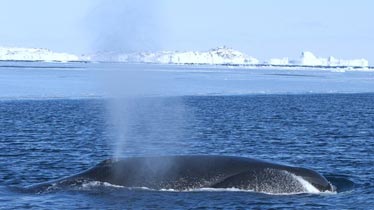Bowhead Whales Reveal Link to the Last Ice Age
Scientists Use Computer Model to Assess the Future of the Bowhead Whale
The extinction of the large mammalian megafauna that roamed much of western Europe and North America around 11,000 years ago is well documented. There have been extensive scientific studies undertaken into the extinction of iconic Ice Age mammals such as the Woolly Mammoth (M. primigenius), as the world suddenly warmed at the end of the last glacial period that marked the beginning of the geological Epoch referred to as the Holocene. However, in comparison, little research had been carried out into how marine megafauna fared with the transition from a cold climate to a much more temperate one.
Studying Ancient DNA
A team of European scientists have attempted to address this imbalance by studying the ancient DNA and extant populations of Arctic Bowhead whales (Balaena mysticetus). It seems these giant Cetaceans not only survived the end of the last Ice Age but the retreating ice sheets opened up extensive new habitats for these large mammals and their population subsequently boomed.
The Arctic Bowhead whale is the only whale species alive today that spends its entire life in Arctic waters. Known also as the Russian whale these creatures, some of whom can weigh more than seventy metric tonnes are believed to be the longest lived of all the mammals. It has been estimated that some individuals can reach the age of two hundred years or more. These cold-adapted mammals have the thickest blubber of any extant whale species, given their adaptations, the warming of the Earth at the beginning of the Holocene should have spelled trouble for these krill-feeding giants but the research team discovered that those whales that had once swum off the coast of the United Kingdom had a population boom.
The Modern Day Arctic Bowhead Whale
Picture credit: Dr Andy Foote
Arctic Bowhead Whales
Dr Andy Foote, (Natural History Museum of Denmark) and his co-authors set out to discover how these whales coped with the climate change. The scientific paper which details their research has just been published in the academic journal “Nature Communications”.
Using DNA from extant whale populations, the team compared this data with DNA extracted from partially fossilised material found in the North Sea. To the team’s surprise, the fossils found indicate that these mammals lived in the southern North Sea during the last Ice Age. In total fossil remains from the North Sea and from the waters around Denmark and Sweden were studied. From this work, a computer model could be created, one that predicted the change in sea ice levels and the subsequent movement of whale populations over thousands of years.
Dr Foote, who is based at the University of Copenhagen (Denmark) commented:
“Based on all previous studies using ancient DNA to estimate the population size it seems the trend was for cold-adapted species either [to] go extinct or decline in numbers at the end of the Ice Age as the temperature increased.”
Prehistoric Mammals
However, whilst the likes of Megaloceros (giant elk), the Woolly Rhino and the Mammoths declined and became extinct it seems that some species of whale actually thrived as the Pleistocene gave way to the Holocene Epoch. The researchers were able to demonstrate that the Bowhead whales essentially moved their range, migrating northwards to follow the retreating ice. It is why these creatures are found in the Arctic today, but their numbers are threatened due to hunting and of course the changing climate of our modern world.
To read an article about Woolly Mammoth blood included in a museum exhibition: Canadian Museum to Display Woolly Mammoth Blood.
Dr Kristin Kaschner, a research affiliate at the University of Freiburg (southern Germany), stated that:
“The retreat of the ice in that particular case actually opened up very large areas where you all of a sudden had these ideal habitat conditions for these Arctic species.”
Long Distance Migrations
Marine animals such as members of the whale family are used to migrating very long distances, in this instance the ability to travel great distances probably worked in the mammal’s favour, they were simply able to move to more suitable habitats. The retreating ice very probably opened up extensive new habitats for them and the population increased as a result.
The scientific data shows that today’s Arctic Bowhead whales can be genetically linked to the same population identified in the fossil material. These cetaceans have a direct link to whale populations that once swam around the British coast during the last glacial period.
This study does not just reflect on past populations, the model can be used to predict whale populations as climate change threatens the Arctic. This research proposes that this whale’s “core habitat” will be greatly reduced in the next fifty years or so. The environment that these whales have to live in could be halved by the end of the 21st century. If whale populations boomed when the habitat got bigger in the past, then the model predicts with shrinking habitat extinction would be a real possibility.
Loss of suitable core habitat in conjunction with the continued whaling could see the end of the Arctic Bowhead whale.


